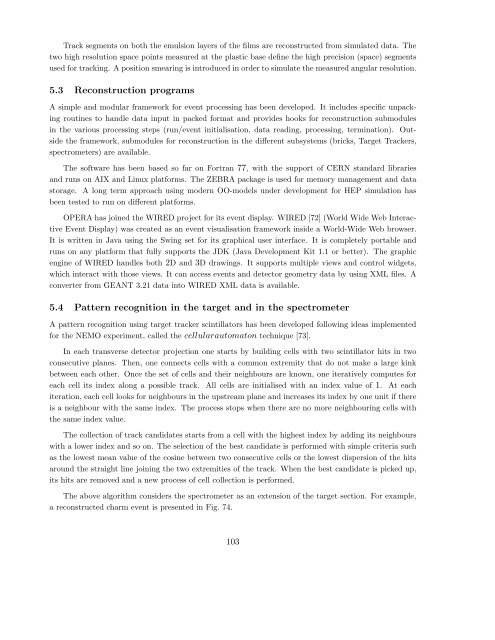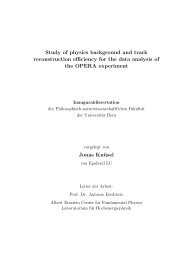Experiment Proposal - opera - Infn
Experiment Proposal - opera - Infn
Experiment Proposal - opera - Infn
Create successful ePaper yourself
Turn your PDF publications into a flip-book with our unique Google optimized e-Paper software.
Track segments on both the emulsion layers of the films are reconstructed from simulated data. The<br />
two high resolution space points measured at the plastic base define the high precision (space) segments<br />
used for tracking. A position smearing is introduced in order to simulate the measured angular resolution.<br />
5.3 Reconstruction programs<br />
A simple and modular framework for event processing has been developed. It includes specific unpacking<br />
routines to handle data input in packed format and provides hooks for reconstruction submodules<br />
in the various processing steps (run/event initialisation, data reading, processing, termination). Outside<br />
the framework, submodules for reconstruction in the different subsystems (bricks, Target Trackers,<br />
spectrometers) are available.<br />
The software has been based so far on Fortran 77, with the support of CERN standard libraries<br />
and runs on AIX and Linux platforms. The ZEBRA package is used for memory management and data<br />
storage. A long term approach using modern OO-models under development for HEP simulation has<br />
been tested to run on different platforms.<br />
OPERA has joined the WIRED project for its event display. WIRED [72] (World Wide Web Interactive<br />
Event Display) was created as an event visualisation framework inside a World-Wide Web browser.<br />
It is written in Java using the Swing set for its graphical user interface. It is completely portable and<br />
runs on any platform that fully supports the JDK (Java Development Kit 1.1 or better). The graphic<br />
engine of WIRED handles both 2D and3D drawings. It supports multiple views and control widgets,<br />
which interact with those views. It can access events and detector geometry data by using XML files. A<br />
converter from GEANT 3.21 data into WIRED XML data is available.<br />
5.4 Patternrecognitioninthetargetandinthespectrometer<br />
A pattern recognition using target tracker scintillators has been developed following ideas implemented<br />
for the NEMO experiment, called the cellularautomaton technique [73].<br />
In each transverse detector projection one starts by building cells with two scintillator hits in two<br />
consecutive planes. Then, one connects cells with a common extremity that do not make a large kink<br />
between each other. Once the set of cells and their neighbours are known, one iteratively computes for<br />
each cell its index along a possible track. All cells are initialised with an index value of 1. At each<br />
iteration, each cell looks for neighbours in the upstream plane and increases its index by one unit if there<br />
is a neighbour with the same index. The process stops when there are no more neighbouring cells with<br />
the same index value.<br />
The collection of track candidates starts from a cell with the highest index by adding its neighbours<br />
with a lower index and so on. The selection of the best candidate is performed with simple criteria such<br />
as the lowest mean value of the cosine between two consecutive cells or the lowest dispersion of the hits<br />
around the straight line joining the two extremities of the track. When the best candidate is picked up,<br />
its hits are removed and a new process of cell collection is performed.<br />
The above algorithm considers the spectrometer as an extension of the target section. For example,<br />
a reconstructed charm event is presented in Fig. 74.<br />
103




